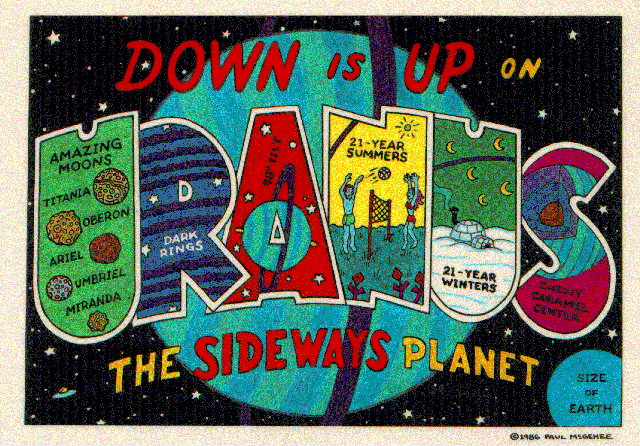

Uranus:
Uranus is the seventh planet from the Sun. It has the third-largest planetary radius and fourth-largest planetary mass in the Solar System. Uranus is similar in composition to Neptune, and both have different bulk chemical composition from that of the larger gas giants Jupiter and Saturn. For this reason, scientists often classify Uranus and Neptune as "ice giants" to distinguish them from the gas giants. Uranus's atmosphere is similar to Jupiter's and Saturn's in its primary composition of hydrogen and helium, but it contains more "ices" such as water, ammonia, and methane, along with traces of other hydrocarbons. It is the coldest planetary atmosphere in the Solar System, with a minimum temperature of 49 K (224 C; 371 F), and has a complex, layered cloud structure with water thought to make up the lowest clouds and methane the uppermost layer of clouds. The interior of Uranus is mainly composed of ices and rock.
Uranus is the only planet whose name is derived from a figure from Greek mythology, from the Latinised version of the Greek god of the sky Ouranos. Like the other giant planets, Uranus has a ring system, a magnetosphere, and numerous moons. The Uranian system has a unique configuration among those of the planets because its axis of rotation is tilted sideways, nearly into the plane of its solar orbit. Its north and south poles, therefore, lie where most other planets have their equators. In 1986, images from Voyager 2 showed Uranus as an almost featureless planet in visible light, without the cloud bands or storms associated with the other giant planets. Observations from Earth have shown seasonal change and increased weather activity as Uranus approached its equinox in 2007. Wind speeds can reach 250 metres per second (900 km/h; 560 mph).

Uranus orbits the Sun once every 84 years. Its average distance from the Sun is roughly 20 AU (3 billion km; 2 billion mi). The difference between its minimum and maximum distance from the Sun is 1.8 AU, larger than that of any other planet, though not as large as that of dwarf planet Pluto. The intensity of sunlight varies inversely with the square of distance, and so on Uranus (at about 20 times the distance from the Sun compared to Earth) it is about 1/400 the intensity of light on Earth.The rotational period of the interior of Uranus is 17 hours, 14 minutes. As on all the giant planets, its upper atmosphere experiences strong winds in the direction of rotation. At some latitudes, such as about 60 degrees south, visible features of the atmosphere move much faster, making a full rotation in as little as 14 hours.
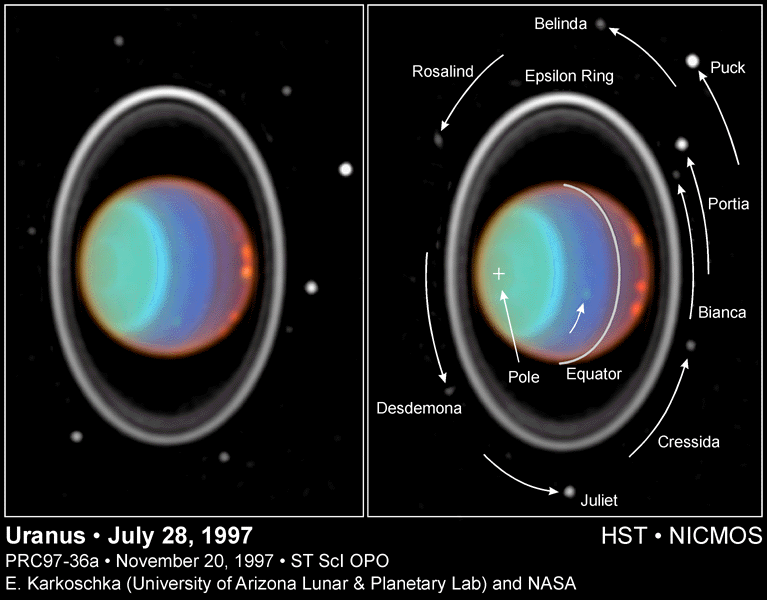
Uranus is distinguished by the fact that it is tipped on its side with a rotational axis that is inclined to the orbit by 98 degrees.
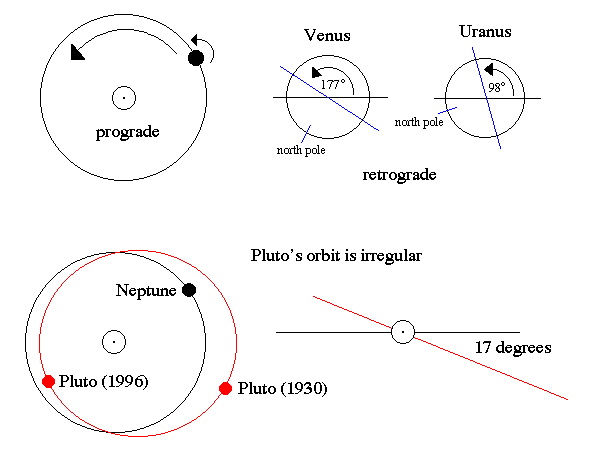
Its unusual position is thought to be the result of a collision with a planet-sized body early in the solar system's history (also note the moons show evidence of a violent event in the past).
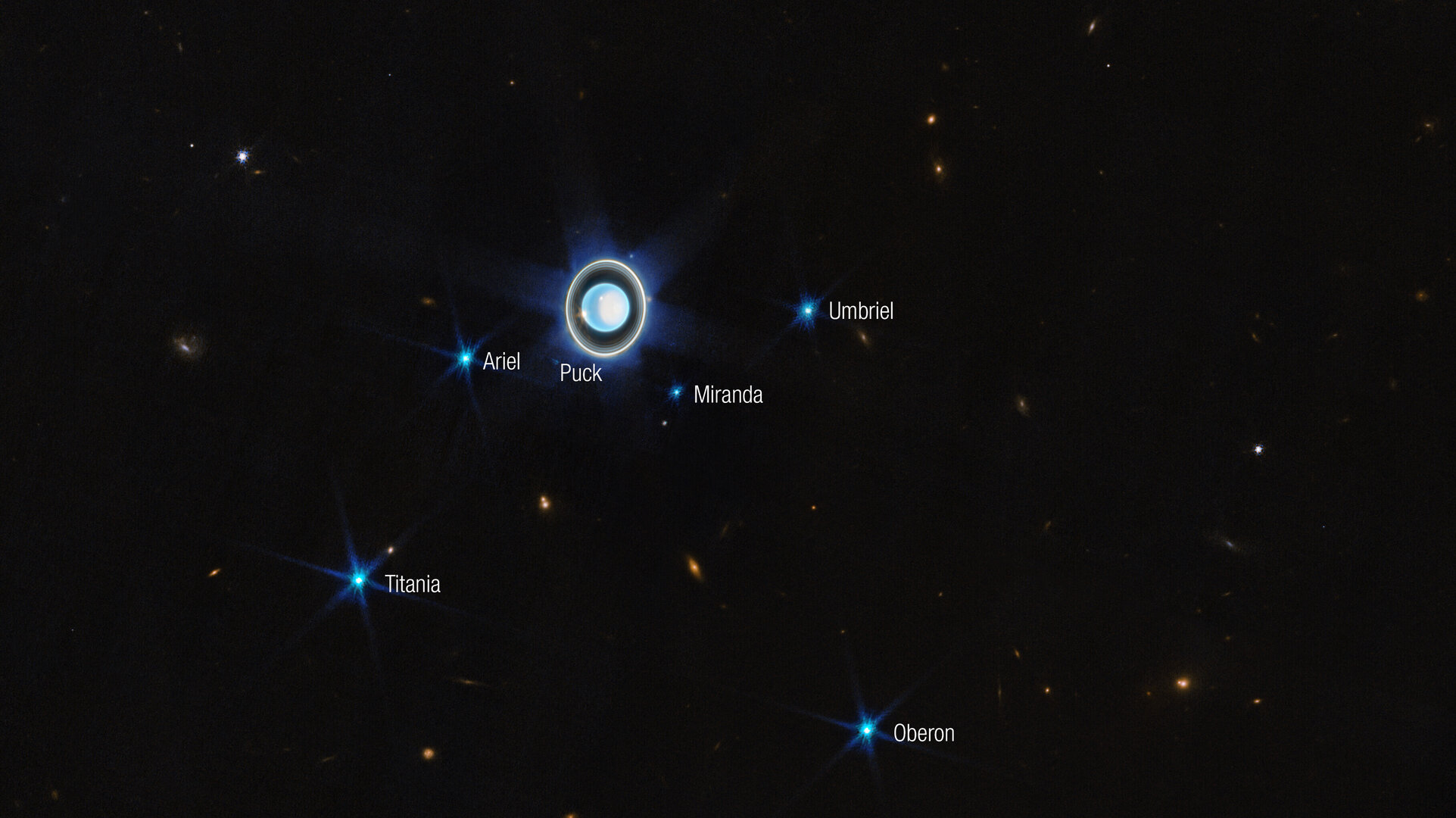
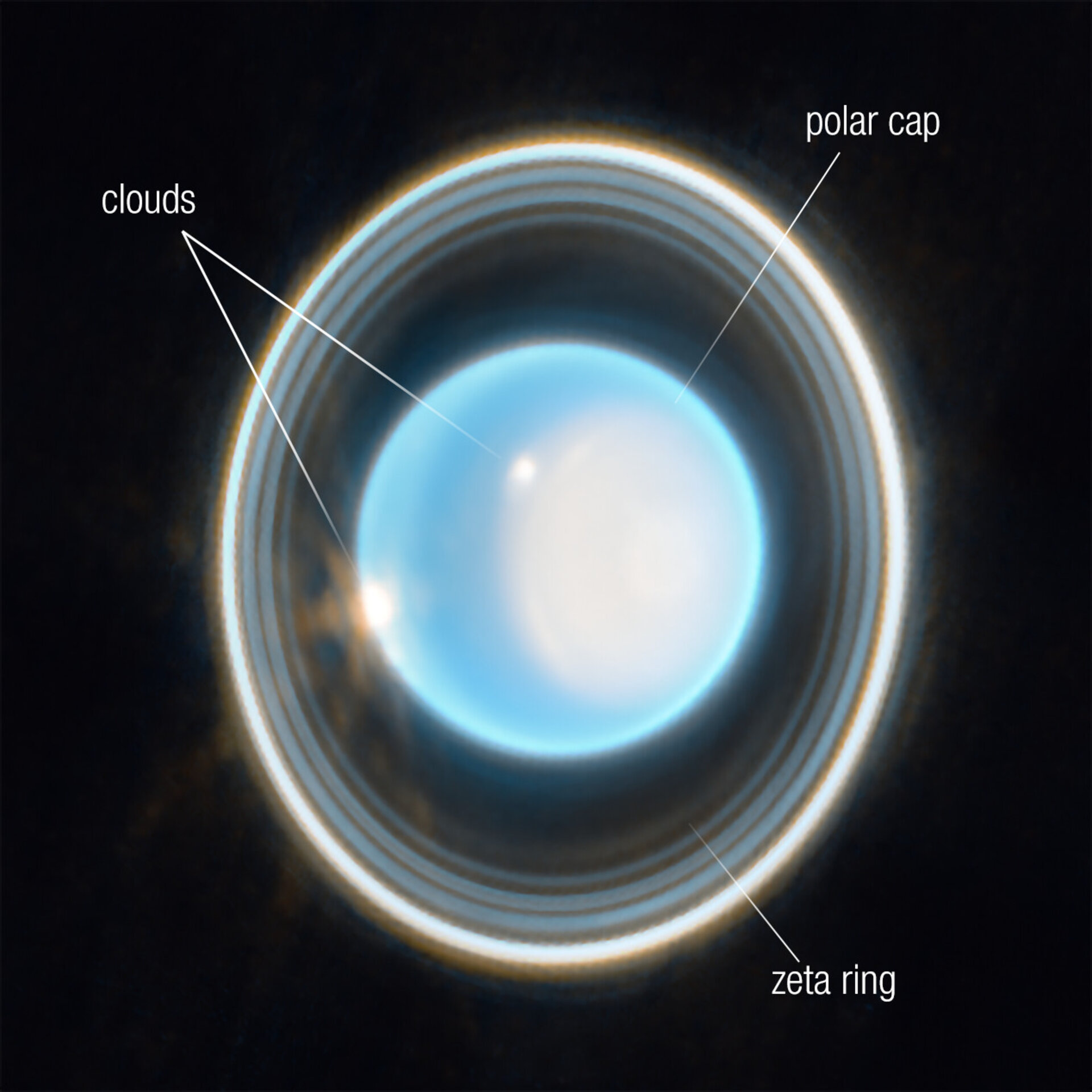
Above, images from the Webb Space Telescope.
Note that this unusual axial tilt leads to a peculiar seasonal and diurnal motion as viewed from the ``surface''. For example, during summer in the northern hemisphere an observer would see the Sun making circles in the sky every 17 hours. As summer wanes, the Sun would gradually move south. Eventually, the Sun would rise and set to the autumnal equinox of equal day and night 21 years after the summer solstice. Then the nights would grow longer until one day the Sun would not rise and a long 21 year night would begin.
Uranus' atmosphere:
Since Uranus lies more than 19 AU from the Sun, it receives 360 times less light and heat from the Sun than Earth. As a result, its atmosphere is extremely cold, with a temperature of about -214C at the 1 bar pressure level (equivalent to the average air pressure at sea level on Earth).
The atmosphere of Uranus is composed of 83% hydrogen, 15% helium, 2% methane and small amounts of acetylene and other hydrocarbons. Methane in the upper atmosphere absorbs red light, giving Uranus its blue-green color. In the inner Jovian worlds (Jupiter and Saturn), ammonium hydrosulfide dominates the coloration of atmospheres with its red's and yellows. But as the temperature drops below 70 K, ammonia gas freezes into ice crystals and drops out of the atmosphere. Methane becomes more dominate and, being a blue gas, the outer Jovian worlds (Uranus and Neptune) go from blue-green to deep blue in their coloration. Note also that methane, CH4 is a greenhouse gas.
Other minor constituents include hydrogen sulfide (H2S), deuterated hydrogen (HD), ethane (C2H6) and acetylene (C2H2). The last two are created by photochemistry the action of sunlight on methane gas. Despite their scarcity, these minor ingredients do have a subtle influence on their surroundings: they condense to form high level hazes which absorb and reflect sunlight, raising the temperature of the upper atmosphere while lowering the temperature of the deeper atmosphere.
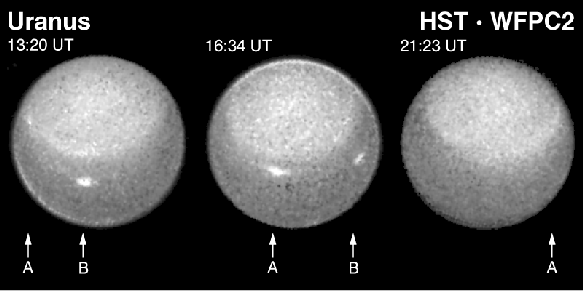
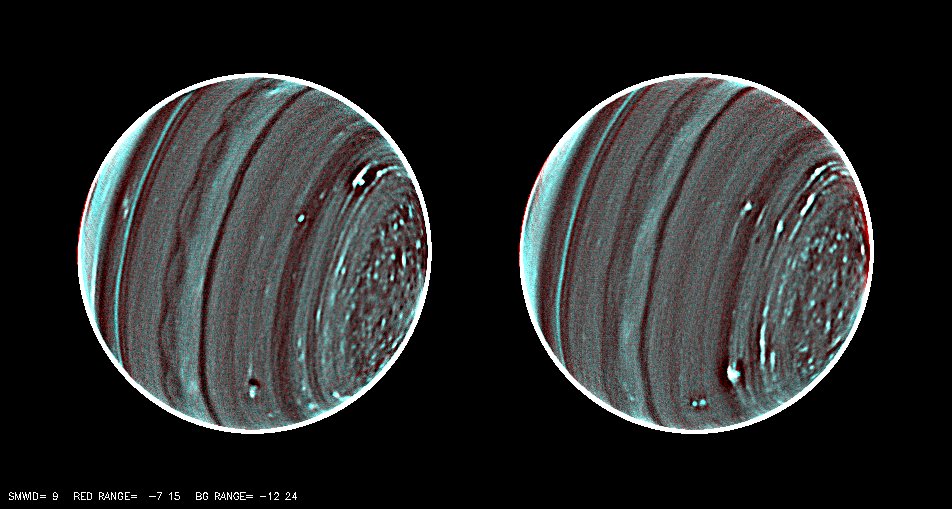
The atmosphere of Uranus is arranged into clouds running at constant latitudes, similar to the orientation of the more vivid latitudinal bands seen on Jupiter and Saturn, although these clouds are only visible in the infrared. Winds at mid-latitudes on Uranus move in the direction of the planet's rotation. These winds blow at velocities between 90 and 360 miles per hour.
Uranus lacks an internal energy source such as Jupiter and Saturn, and thus its atmosphere energy system is much less active, resulting in fewer features (i.e. storms, eddies, etc.). Cloud patterns are only seen at the warmer, lower levels deep below the atmospheric haze. In addition, the tilted axis of Uranus produces uneven warming in the two hemisphere which produce long-term North-South flows across the latitude zones. The combination of these effects means that the atmospheric features are washed out much like Saturn.
Uranus Internal Structure:
Uranus's mass is roughly 14.5 times that of Earth, making it the least massive of the giant planets. Its diameter is slightly larger than Neptune's at roughly four times that of Earth. A resulting density of 1.27 g/cm3 makes Uranus the second least dense planet, after Saturn. This value indicates that it is made primarily of various ices, such as water, ammonia, and methane. The total mass of ice in Uranus's interior is not precisely known, because different figures emerge depending on the model chosen; it must be between 9.3 and 13.5 Earth masses. Hydrogen and helium constitute only a small part of the total, with between 0.5 and 1.5 Earth masses. The remainder of the non-ice mass (0.5 to 3.7 Earth masses) is accounted for by rocky material.
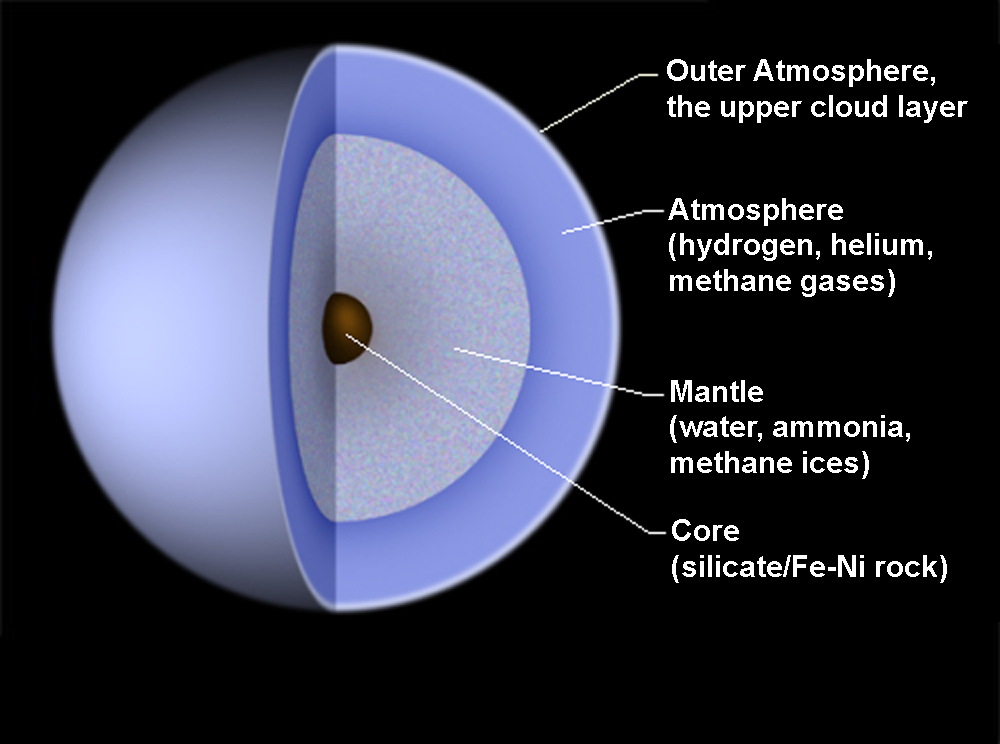
The standard model of Uranus's structure is that it consists of three layers: a rocky (silicate/iron nickel) core in the centre, an icy mantle in the middle and an outer gaseous hydrogen/helium envelope. The core is relatively small, with a mass of only 0.55 Earth masses and a radius less than 20% of Uranus's; the mantle comprises its bulk, with around 13.4 Earth masses, and the upper atmosphere is relatively insubstantial, weighing about 0.5 Earth masses and extending for the last 20% of Uranus's radius. Uranus's core density is around 9 g/cm3, with a pressure in the centre of 8 million bars (800 GPa) and a temperature of about 5000 K. The ice mantle is not in fact composed of ice in the conventional sense, but of a hot and dense fluid consisting of water, ammonia and other volatiles. This fluid, which has a high electrical conductivity, is sometimes called a water-ammonia ocean.
The extreme pressure and temperature deep within Uranus may break up the methane molecules, with the carbon atoms condensing into crystals of diamond that rain down through the mantle like hailstones. Very-high-pressure experiments at the Lawrence Livermore National Laboratory suggest that the base of the mantle may comprise an ocean of liquid diamond, with floating solid 'diamond-bergs'.
The bulk compositions of Uranus and Neptune are different from those of Jupiter and Saturn, with ice dominating over gases, hence justifying their separate classification as ice giants. There may be a layer of ionic water where the water molecules break down into a soup of hydrogen and oxygen ions, and deeper down superionic water in which the oxygen crystallises but the hydrogen ions move freely within the oxygen lattice.
Although the model considered above is reasonably standard, it is not unique; other models also satisfy observations. For instance, if substantial amounts of hydrogen and rocky material are mixed in the ice mantle, the total mass of ices in the interior will be lower, and, correspondingly, the total mass of rocks and hydrogen will be higher. Presently available data does not allow a scientific determination which model is correct. The fluid interior structure of Uranus means that it has no solid surface. The gaseous atmosphere gradually transitions into the internal liquid layers. For the sake of convenience, a revolving oblate spheroid set at the point at which atmospheric pressure equals 1 bar (100 kPa) is conditionally designated as a "surface". It has equatorial and polar radii of 25,559 km (15,881.6 mi) and 24,973 km (15,518 mi), respectively.
Uranus's internal heat appears markedly lower than that of the other giant planets; in astronomical terms, it has a low thermal flux. Why Uranus's internal temperature is so low is still not understood. Neptune, which is Uranus's near twin in size and composition, radiates 2.61 times as much energy into space as it receives from the Sun, but Uranus radiates hardly any excess heat at all. The total power radiated by Uranus in the far infrared (i.e. heat) part of the spectrum is 1.060 times the solar energy absorbed in its atmosphere. Uranus's heat flux is only 0.042 W/m2, which is lower than the internal heat flux of Earth of about 0.075 W/m2. The lowest temperature recorded in Uranus's tropopause is 49 K (224.2 C; 371.5 F), making Uranus the coldest planet in the Solar System.
One of the hypotheses for this discrepancy suggests that when Uranus was hit by a supermassive impactor, which caused it to expel most of its primordial heat, it was left with a depleted core temperature. Another hypothesis is that some form of barrier exists in Uranus's upper layers that prevents the core's heat from reaching the surface. For example, convection may take place in a set of compositionally different layers, which may inhibit the upward heat transport; perhaps double diffusive convection is a limiting factor.
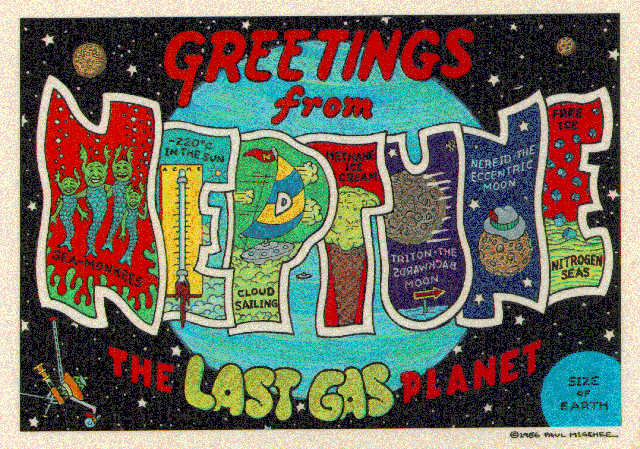
Neptune:
Neptune is the eighth and farthest known planet from the Sun in the Solar System. In the Solar System, it is the fourth-largest planet by diameter, the third-most-massive planet, and the densest giant planet. Neptune is 17 times the mass of Earth and is slightly more massive than its near-twin Uranus, which is 15 times the mass of Earth and slightly larger than Neptune. It has an equatorial radius of 24,900 kilometers (about 1.4 Earth radii). If Neptune were hollow, it could contain nearly 60 Earths. It has a mean density of 1.7 gm/cc. Neptune orbits the Sun once every 164.8 years at an average distance of 30.1 astronomical units. It is named after the Roman god of the sea and has the astronomical symbol , a stylised version of the god Neptune's trident.
Neptune's composition can be compared and contrasted with the Solar System's other giant planets. Like Jupiter and Saturn, Neptune's atmosphere is composed primarily of hydrogen and helium, along with traces of hydrocarbons and possibly nitrogen, but it contains a higher proportion of "ices" such as water, ammonia, and methane. However, its interior, like that of Uranus, is primarily composed of ices and rock, which is why Uranus and Neptune are normally considered "ice giants" to emphasise this distinction. Traces of methane in the outermost regions in part account for the planet's blue appearance.
In contrast to the hazy, relatively featureless atmosphere of Uranus, Neptune's atmosphere has active and visible weather patterns. For example, at the time of the Voyager 2 flyby in 1989, the planet's southern hemisphere had a Great Dark Spot comparable to the Great Red Spot on Jupiter. These weather patterns are driven by the strongest sustained winds of any planet in the Solar System, with recorded wind speeds as high as 2,100 kilometres per hour (580 m/s; 1,300 mph). Because of its great distance from the Sun, Neptune's outer atmosphere is one of the coldest places in the Solar System, with temperatures at its cloud tops approaching 55 K (218 C). Temperatures at the planet's centre are approximately 5,400 K (5,100 C). Neptune has a faint and fragmented ring system (labelled "arcs"), which was first detected during the 1960s and confirmed by Voyager 2.
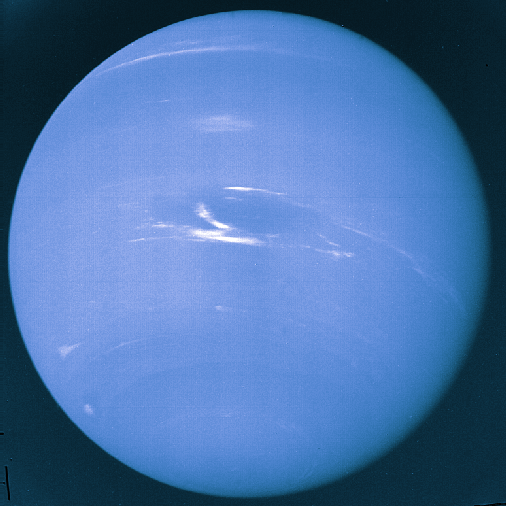
Neptune has eight moons, six of which were found by Voyager. A day on Neptune is 16 hours and 6.7 minutes long. Neptune was discovered on September 23, 1846 by Johann Gottfried Galle, of the Berlin Observatory, and Louis d'Arrest, an astronomy student, through mathematical predictions made by Urbain Jean Joseph Le Verrier.
Neptune's atmosphere:
At high altitudes, Neptune's atmosphere is 80% hydrogen and 19% helium. A trace amount of methane is also present. Prominent absorption bands of methane exist at wavelengths above 600 nm, in the red and infrared portion of the spectrum. As with Uranus, this absorption of red light by the atmospheric methane is part of what gives Neptune its blue hue, although Neptune's vivid azure differs from Uranus's milder cyan. Because Neptune's atmospheric methane content is similar to that of Uranus, some unknown atmospheric constituent is thought to contribute to Neptune's color.
Unlike Uranus with its lack of atmospheric features, Neptune is a dynamic planet with several large, dark spots reminiscent of Jupiter's hurricane-like storms. The largest spot, known as the Great Dark Spot, is about the size of the earth and is similar to the Great Red Spot on Jupiter.
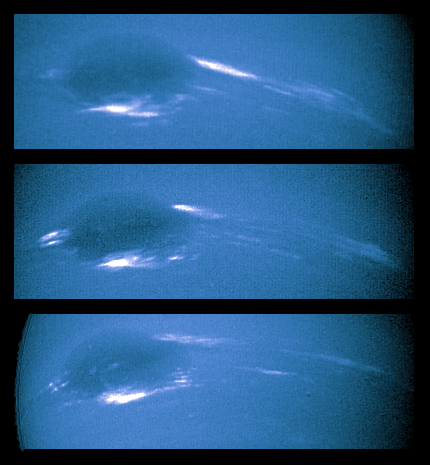
Other dark spots display cyclone-like structure in their centers.
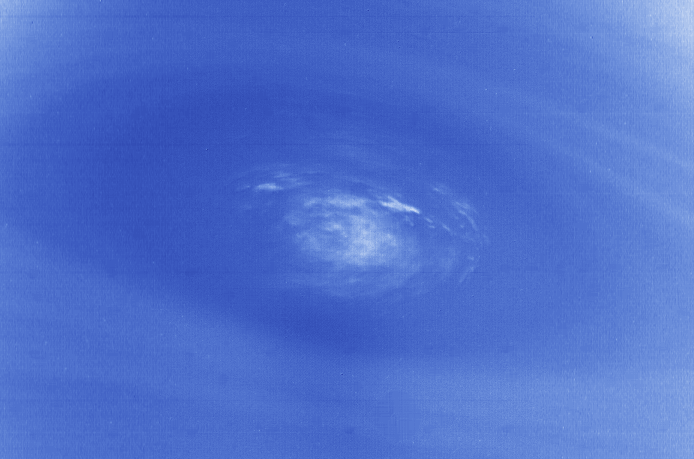
Just like the storms on Jupiter, the dark spots on Neptune ``tumble'' along the zones absorbing smaller storms to power themselves. The most surprising thing about these storms is that, unlike Jupiter, they are short-lived. Recent HST images do not show the Great Dark Spot.
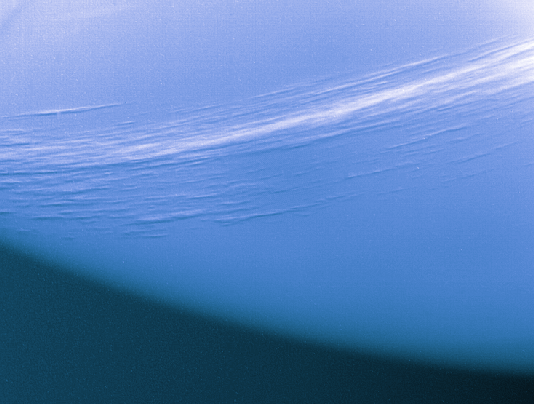
Long bright clouds, similar to cirrus clouds on Earth, were seen high in Neptune's atmosphere. At low northern latitudes, Voyager captured images of cloud streaks casting their shadows on cloud decks below.
The strongest winds on any planet were measured on Neptune. Most of the winds there blow westward, opposite to the rotation of the planet. Near the Great Dark Spot, winds blow up to 1,200 miles an hour.
Neptune emits 2.7 times more energy than it receives from the Sun. This access energy powers the atmosphere to produce the storms that are not seen on its twin planet Uranus. The source of internal energy cannot be due solely to leftover energy from formation (i.e. Jupiter) since Neptune is smaller and would have radiated away the energy long ago. Nor is it due to an unusual chemical change, such as the helium rain for Saturn. Rather, it appears that Neptune is more efficient at trapping leftover formation heat due to the fact that methane is highly abundant in Neptune's atmosphere, and methane is an excellent insulator of heat (i.e. the greenhouse effect). Neptune has a sub-zero type greenhouse effect that is trapping formation heat that should have been radiated billions of years ago like Uranus.
Uranus/Neptune interior:
The interiors of Uranus and Neptune are almost identical, due to the fact they are similar in mass and size. Both have rocky cores like Jupiter and Saturn. But at that point the similarity ends. The pressures are never sufficient to convert molecular hydrogen to metallic hydrogen in the interiors of Uranus and Neptune. Instead, a large mantle of icy water and ammonia forms about 20,000 km below the surface.
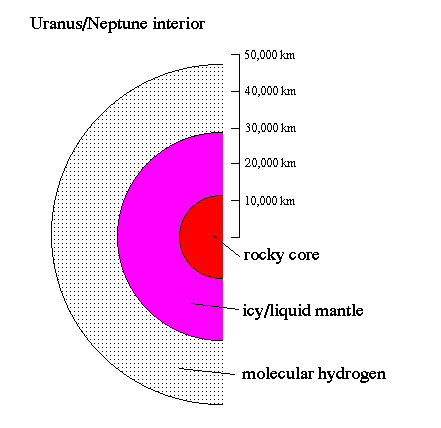
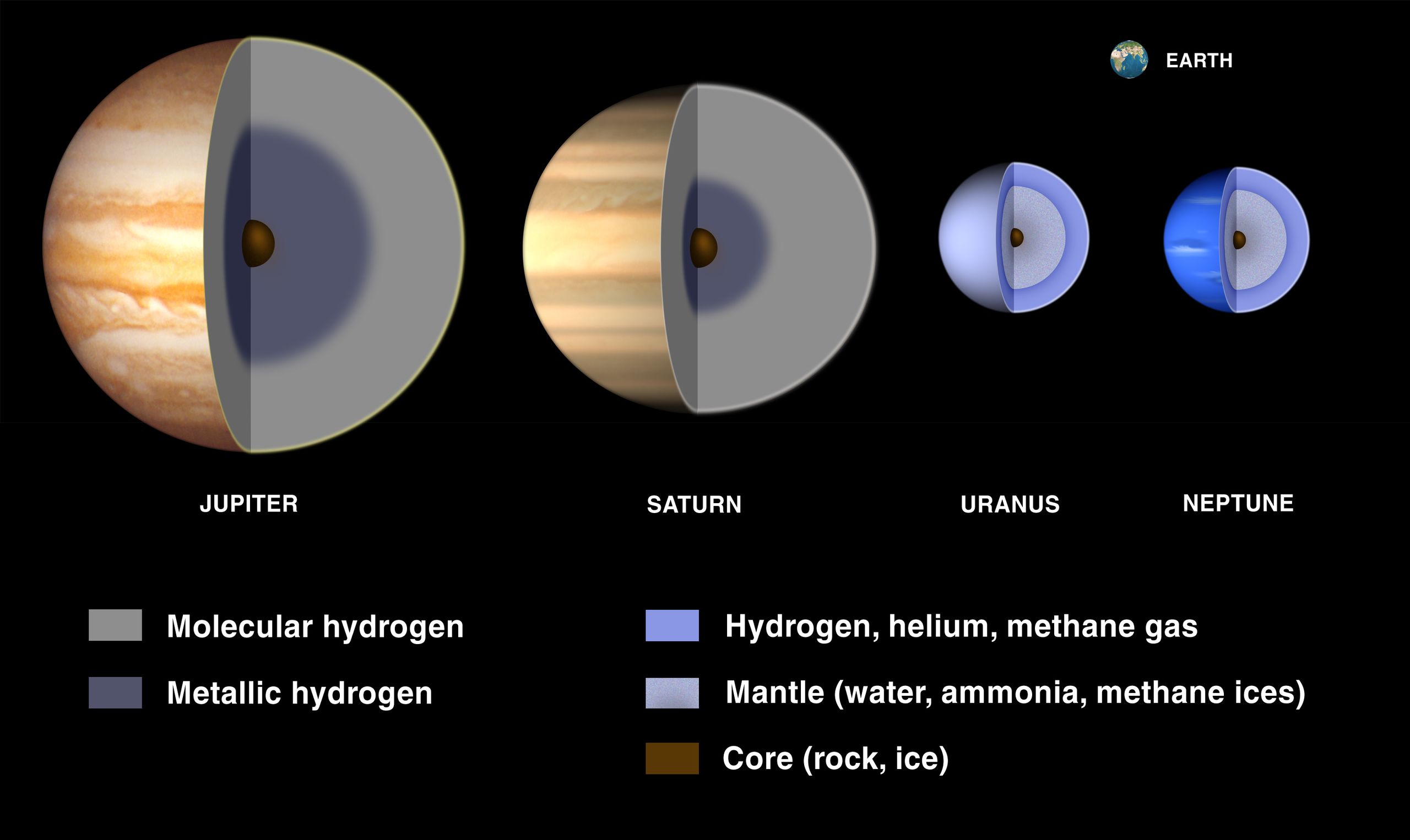
Uranus/Neptune magnetic field:
The magnetic fields for both Uranus and Neptune are unusual and are not well understood at this time. As the diagram below shows, the magnetic fields of the strongest three worlds, Jupiter, Saturn and the Earth, are all roughly aligned with the rotational axis of the planets. The generation of these magnetic fields occurs in liquid mantles around solid cores (liquid rock for the Earth, metallic hydrogen for Jupiter and Saturn).
Uranus and Neptune, on the other hand, have radically different magnetic fields. Not only are they not aligned with the rotational axis of the planet, but neither are they located at the center of the planet either. The magnetic fields are probably be generated by local events in the icy mantles of both planets and may be unstable.
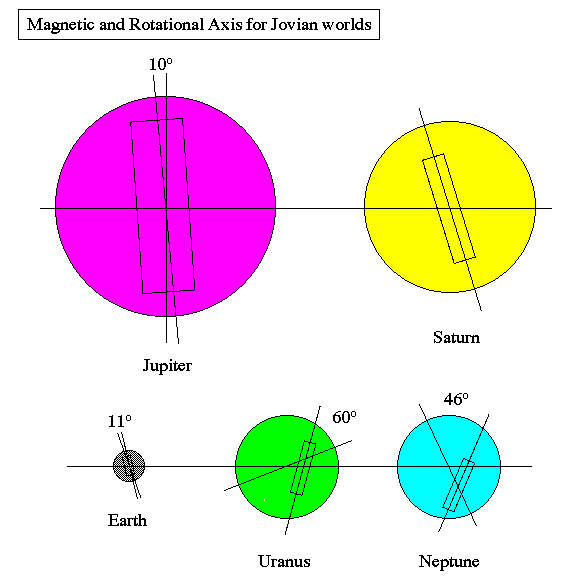

|
|

|